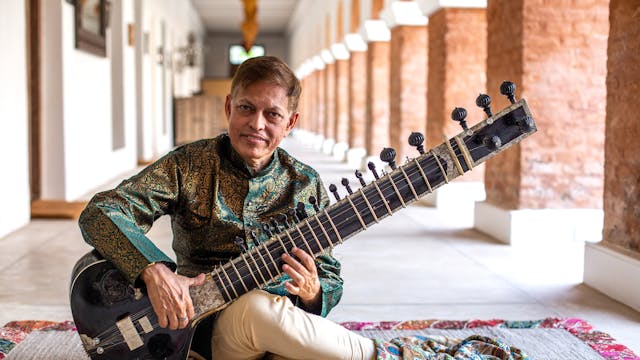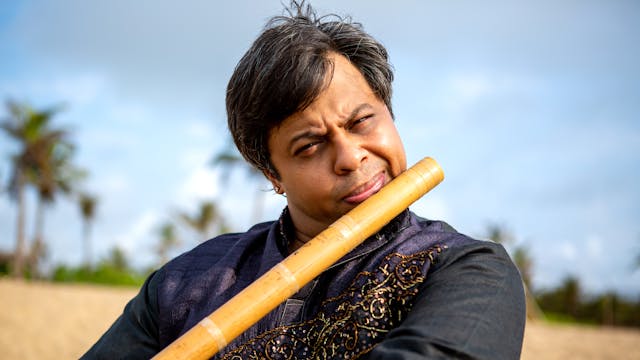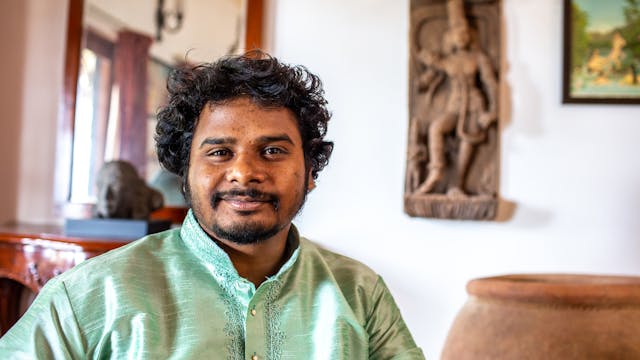Anupama Bhagwat | Shahana
Sounds of India
•
10m
Born out of the parent scale Kafi, Raag Shahana is an upper-tetra chord dominant raga that draws its haunting strains from Bhimpalasi and Bageshree. The Darbar team filmed Anupama Bhagwat in an isolated outdoor location in Bangalore, India, playing this midnight raga. Bhagwat plays the jod, a section that follows the introduction or alap of the raga and carries within it, a linear pulse without any rhythmic accompaniment.
Seated under a colonnade of vertical stone pillars overlooking a garden, Bhagwat goes into a trance-like mode, her sitar creating an immersive intimacy as it merges with its surroundings. Lost in a world devoid of an assembled, alert audience or any associated equipage of a live performance, Bhagwat plunges into Shahana weaving a tapestry of indiscreet longings with Shahana's exquisite tensity.
As she approaches the climax, she adds trills to the clearly carved-out bols (syllables) on the linear time-line, tapping the section between the pumpkin and the neck of the sitar to accentuate the down-beats of the linear rhythm. The polyphonic microtones emanating from the perfectly tuned sympathetic strings collude flawlessly with the tonal sentences she plays on the main strings.
The dappled sunlight peeping through the interstices of the trees cast upon her a halo, revealing the hint of a tattoo in Devanagari script on her right arm as the camera continues to capture a sidelong glance of her.
Bhagwat’s controlled virtuosity and her sensitive treatment of ragas in a lyrical method patterned after the human voice called ‘gayaki ang’ makes her one of the leading sitarists of her generation. She is an exponent of the Imdadkhani gharana, a style eponymously named after its creator Ustad Imdad Khan (1848 – 1920) for his major musical influence over the style. Her varied approach reflects the eclecticism of her guru Bimalendu Mukherjee, a sitarist who also played veena, surbahar, sarod, sursingar, mandra bahar, dilruba, esraj, tar shehnai, and pakhawaj. Now based in Bangalore, she continues to refine her style while touring to acclaim.
The name ‘Shahana’ is of Persian origin and literally translates to ‘royal demeanour.’It is a close cousin of the more famous Raag Bageshri, sharing the same notes (SRgmPDnS), but focuses much more on shuddh Dha as a melodic end-point. It is often considered to be part of the Kanada family - performers often descend with the characteristic phrase nP, gmRS.
Sitarist-scholar Deepak Raja notes that the raga is mentioned in medieval texts as being related to a Persian melody known as firodast, and that poetry set to it often features imagery related to spring and the monsoon season.
Musician:
- Anupama Bhagwat (sitar)
Raag Shahana, Thaat: Kafi, Samay: midnight
Recorded for Darbar in 2014, on location in Bangalore.
Up Next in Sounds of India
-
Budhaditya Mukherjee | Yaman Kalyan
Filmed and recorded live at Bawali Rajbari, Kolkata, India.
Musicians:
- Pandit Budhaditya Mukherjee (sitar)Raag Yaman Kalyan, Thaat: Kalyan, Samay: early evening
Raag Yaman Kalyan is a combination of Raag Yaman and its parent scale Kalyan. Although shudh Ma is not used in both Raag Yaman...
-
Shashank Subramanyan | Nasikabhushani
Filmed and recorded live at Mahabalipuram, Tamil Nadu
Musician:
- Shashank Subramanyam (flute)Ragam tanam in Raga Nasikabhushani
A devotional raga in spirit, Raga Nasikabhushani is a ‘vivadi’ or a dissonant melodic scale that has been scantily used in Carnatic compositions. Against the cra...
-
Ramakant Gaikwad | Marwa
Filmed and recorded live at Mulshi, Maharashtra
Musicians:
- Ramakant Gaikwad (khayal)
- Ramkrishna Karambelkar (tabla)
- Abhinay Laxmikant Ravonde (harmonium)
- Gayatri Gaikwad & Dr. Aparna Shenoy (tanpuras)Raag Marwa, Thaat: Marwa, Samay: sunset
Recorded live against the stunning, rugg...



